Healing through memory journaling combines scrapbooking with introspective writing to explore and process your past experiences. You'll create a safe space for reflection, using art and words to tell your story. Don't worry about perfection; messy pages often hold the most authentic narratives. Incorporate mindfulness techniques to stay present as you work, and use prompts to dive deeper into your emotions. If anxiety creeps in, try digital scrapbooking for easier editing. Collaborating with others can provide shared healing and support. By celebrating your progress through memory journals, you'll gain valuable insights into your personal growth journey. The path to emotional healing awaits as you turn the page.
Understanding Therapeutic Memory Journaling
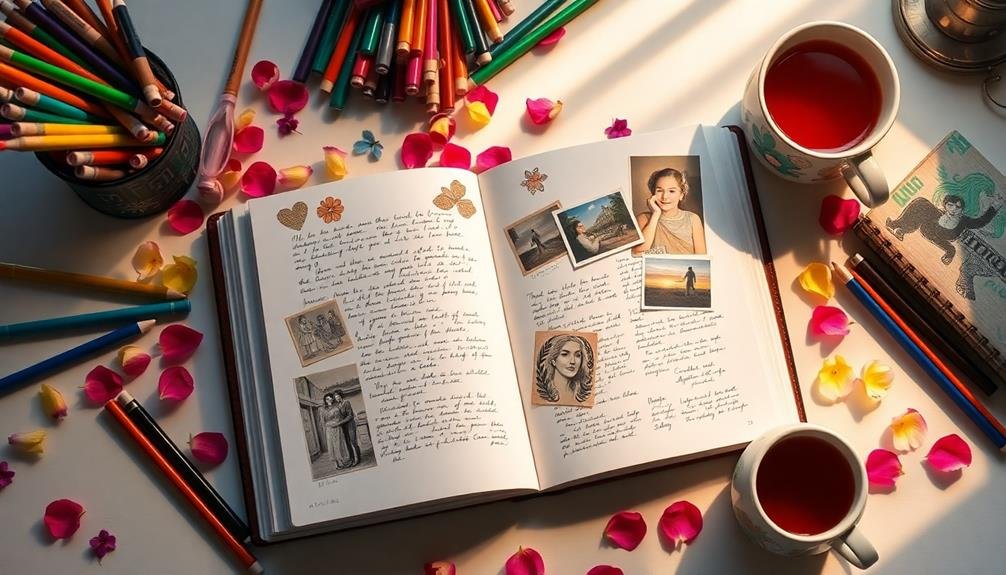
Why do scrapbookers often struggle to capture the essence of their memories? It's because they focus solely on visual elements, neglecting the power of words to convey emotions and context.
This is where therapeutic memory journaling comes in.
Therapeutic memory journaling is a technique that combines scrapbooking with introspective writing. It's not just about recording events; it's about exploring your feelings, thoughts, and personal growth associated with those memories.
You'll explore deeper into your experiences, uncovering insights and healing through the process.
To start, choose a memory that resonates with you. Write freely about what happened, how you felt then, and how you feel now.
Don't censor yourself; let your thoughts flow. As you write, you may discover new perspectives or emotions you hadn't considered before.
Next, reflect on how this memory has shaped you. What did you learn? How has it influenced your life?
This reflection adds depth to your scrapbook pages, transforming them from mere photo displays into meaningful life stories.
Choosing the Right Scrapbooking Materials
Once you've honed your therapeutic memory journaling skills, it's time to select the right materials for your scrapbook. Choose acid-free papers and adhesives to preserve your memories for years to come.
Opt for high-quality cardstock as your base, ensuring it's sturdy enough to support embellishments. Select a variety of patterned papers that complement your photos and journaling.
For writing, use archival-quality pens that won't bleed or fade over time. Gel pens offer smooth writing, while fine-tip markers provide precision for detailed work.
Consider using stickers, washi tape, and die-cuts to add visual interest and texture to your pages. Invest in a good pair of scissors and a paper trimmer for clean, precise cuts.
Adhesives like double-sided tape, glue dots, and archival-safe liquid glue will help secure your elements. Don't forget about photo corners or sleeves to protect and showcase your pictures.
Lastly, choose a durable album with expandable pages to accommodate your growing collection of memories. By selecting the right materials, you'll create a lasting representation of your therapeutic journey through scrapbooking.
Creating a Safe Journaling Space
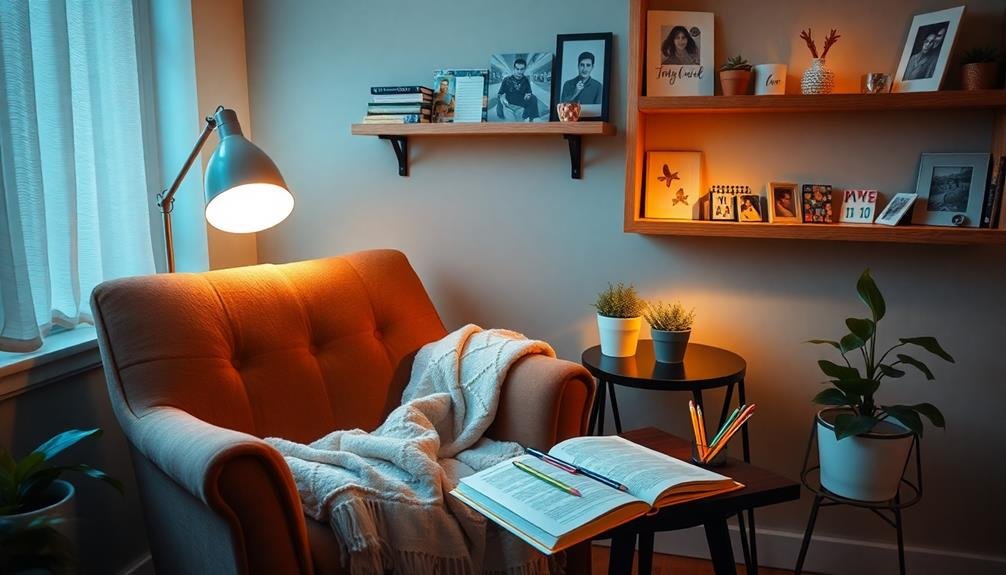
Creating a safe journaling space is vital for therapeutic scrapbooking. You'll need a quiet, private area where you can focus on your thoughts and emotions without interruption.
Choose a comfortable spot in your home, like a cozy corner or a dedicated desk, where you feel at ease and inspired. Guarantee good lighting and ventilation to enhance your mood and creativity.
Set boundaries with family members or roommates, letting them know when you're journaling and need uninterrupted time. Keep your scrapbooking supplies organized and easily accessible in this space.
Consider using a lockable box or drawer for storing your journal and personal mementos if privacy is a concern.
Create a calming atmosphere with soft music, scented candles, or essential oils. Surround yourself with meaningful objects that inspire positive memories and emotions.
Display photos, quotes, or small keepsakes that resonate with your scrapbooking journey.
Establish a routine for your journaling sessions, setting aside specific times when you're least likely to be disturbed. This consistency will help you maintain the habit and make the most of your therapeutic scrapbooking experience.
Embracing Imperfection in Memory Keeping
You don't need perfect pages to capture perfect memories.
Those messy, unfiltered scrapbook entries often tell the most authentic stories of your life.
Embrace the imperfections in your journaling, as they're likely to spark more joy and evoke stronger emotions when you look back on them years from now.
Messy Pages Tell Stories
Perfection often stands in the way of authentic storytelling. When you allow yourself to create messy pages in your scrapbook, you're embracing the raw, unfiltered essence of your memories. These imperfect spreads can reveal more about your experiences than polished layouts ever could.
Don't be afraid to let your emotions guide your hand. Smudges, tears, and hasty scribbles all add depth to your narrative. They capture the urgency of the moment and the intensity of your feelings. Consider incorporating these elements:
| Messy Element | Emotional Impact |
|---|---|
| Tear stains | Vulnerability |
| Coffee rings | Daily life |
| Wrinkled paper | Passage of time |
| Scribbled out | Second thoughts |
Unfiltered Memories Spark Joy
While messy pages tell powerful stories, there's a profound joy in embracing unfiltered memories. When you allow yourself to record experiences without censorship, you tap into a wellspring of authenticity that can't be replicated.
Don't worry about perfect handwriting or polished prose; instead, focus on capturing the raw essence of your memories.
Unfiltered journaling in your scrapbooks lets you preserve the full spectrum of emotions associated with each moment. You'll find that even seemingly mundane details can spark joy years later. Write about the smells, sounds, and textures that surrounded you. Include your honest thoughts and feelings, even if they're complex or contradictory.
This approach to memory keeping allows you to create a more genuine representation of your life. It's not about crafting a picture-perfect narrative but about honoring the beauty in imperfection.
As you flip through your scrapbook, you'll discover that these unfiltered entries often become the most cherished. They provide a window into your past self, complete with all its quirks and vulnerabilities, sparking joy and fostering self-acceptance.
Incorporating Mindfulness Into Scrapbooking

Mindfulness can breathe new life into your scrapbooking practice, transforming it from a simple hobby into a powerful tool for self-reflection and personal growth. By incorporating mindfulness techniques, you'll deepen your connection to your memories and enhance your creative process.
Start by setting an intention before each scrapbooking session. Focus on the present moment, allowing yourself to fully engage with the materials and memories at hand. As you work, pay attention to your thoughts and emotions without judgment. This awareness can lead to profound insights and a greater appreciation for the moments you're preserving.
Consider these mindful scrapbooking practices:
- Use journaling prompts to explore your feelings about specific memories
- Practice gratitude by highlighting positive aspects of each event
- Incorporate sensory details to evoke stronger connections to your experiences
- Create mandalas or zentangles as meditative elements in your layouts
- Include affirmations or inspirational quotes that resonate with your current state of mind
Exploring Emotions Through Visual Elements
Beyond words, visual elements in scrapbooking can powerfully convey emotions and enhance your journaling experience. Colors, shapes, textures, and images work together to express feelings that might be difficult to articulate.
When exploring emotions through visual elements, start by selecting a color palette that reflects your mood. Warm tones like reds and oranges can evoke passion or energy, while cool blues and greens might represent calmness or melancholy.
Consider the shapes you incorporate into your layout. Sharp angles can convey tension or conflict, while soft curves might suggest comfort or harmony. Experiment with textures to add depth to your emotional expression. Rough surfaces can represent struggle, while smooth finishes might indicate peace or resolution.
Don't overlook the power of images; choose photographs or illustrations that resonate with your emotional state. As you arrange these elements, pay attention to composition. The way you place items on your page can influence the overall emotional impact.
Crowded layouts might express overwhelm, while open spaces can suggest freedom or loneliness. By thoughtfully combining these visual components, you'll create a scrapbook page that speaks volumes about your emotional journey, complementing your written reflections.
Writing Prompts for Healing Memories
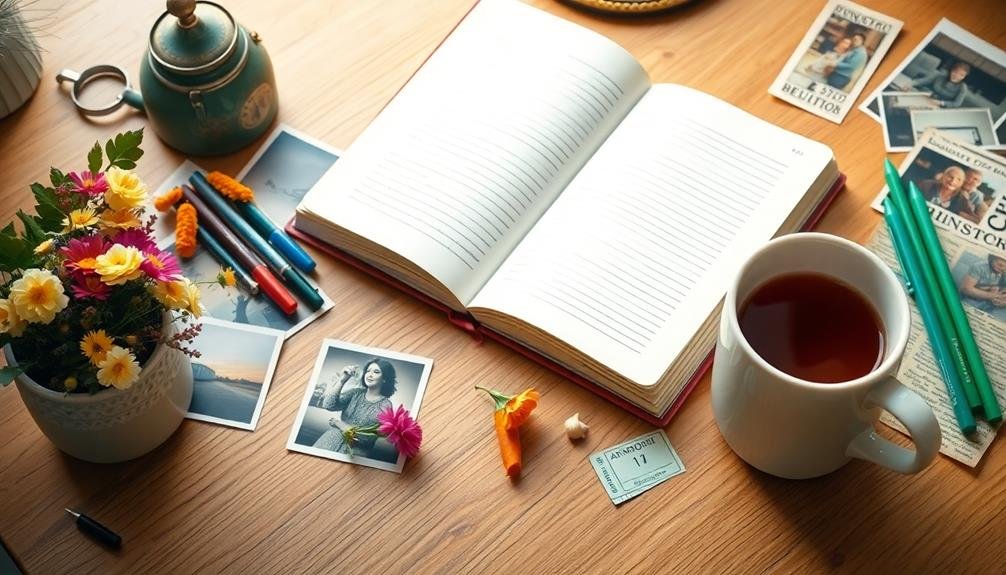
In accordance with the healing process, writing prompts can serve as powerful tools for processing and reconciling difficult memories. When you're scrapbooking, consider using these prompts to explore deeper into your experiences and emotions.
Start by choosing a memory that feels unresolved or painful, then select a prompt that resonates with you. As you write, don't censor yourself. Let your thoughts flow freely onto the page.
Here are some effective prompts to get you started:
- Describe the event as if you're watching it from afar
- Write a letter to your past self about this experience
- Explore how this memory has shaped who you're today
- Imagine a different outcome and detail how it might've changed things
- List the lessons you've learned from this experience
Combining Photos With Therapeutic Journaling
Pairing photos with therapeutic journaling can amplify the healing power of your scrapbooking practice. As you select images that resonate with your memories, you're creating a visual anchor for your emotions and experiences. This combination allows you to explore your feelings more deeply and gain new perspectives on past events.
When combining photos with journaling, consider these techniques:
| Photo Type | Journaling Approach |
|---|---|
| Candid shots | Describe emotions and sensations |
| Landscapes | Reflect on personal growth |
| Group photos | Explore relationships and dynamics |
| Objects | Unpack symbolism and significance |
Start by choosing a photo that evokes strong emotions or memories. Write freely about what you see, feel, and remember. Don't censor yourself; let your thoughts flow naturally. As you write, you might uncover hidden feelings or forgotten details.
Try writing from different perspectives. If you're in the photo, describe the scene as if you're an observer. If it's a place, imagine what it would say if it could speak. This exercise can help you gain new insights and process complex emotions tied to the image and memory.
Art Therapy Techniques for Scrapbookers
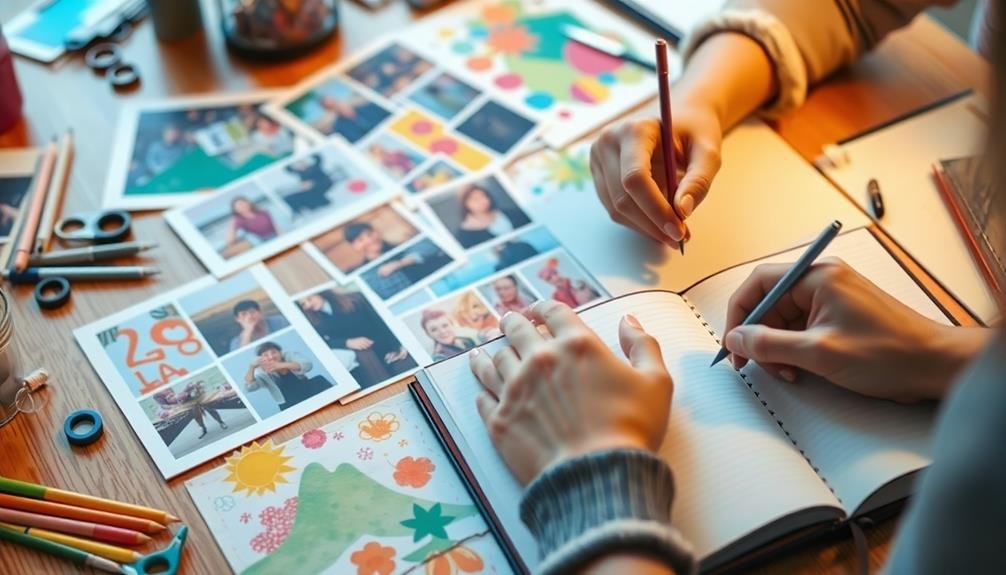
Art therapy techniques frequently offer scrapbookers powerful tools to enhance their journaling practice. By incorporating visual elements, you can express emotions and memories that words alone might struggle to convey. These techniques allow you to tap into your subconscious, revealing deeper insights and fostering personal growth.
To get started with art therapy in your scrapbooking, try these methods:
- Create abstract backgrounds using paint, ink, or collage to represent your mood
- Draw symbols or mandalas that represent significant life events or relationships
- Use color psychology to evoke specific emotions in your layouts
- Incorporate texture through mixed media to add depth to your journaling
- Experiment with different art styles to express various aspects of your personality
As you explore these techniques, don't worry about artistic perfection. The goal is self-expression and emotional release. Let your intuition guide you, and allow yourself to be surprised by what emerges.
You'll find that combining art therapy with traditional journaling can lead to more meaningful and cathartic scrapbooking experiences. This approach not only preserves memories but also promotes healing and self-discovery through creative exploration.
Overcoming Anxiety While Memory Keeping
Many scrapbookers experience anxiety when trying to capture and preserve their memories. This anxiety can stem from perfectionism, fear of forgetting important details, or feeling overwhelmed by the sheer volume of memories to document.
To overcome these feelings, start by setting realistic expectations for yourself. Remember that your scrapbook doesn't need to be perfect; it's a personal reflection of your experiences.
Break down your memory-keeping process into manageable steps. Begin with small, achievable goals, such as journaling about one specific event or creating a single layout. Focus on the joy of reliving your memories rather than the pressure to document everything perfectly.
If you're feeling stuck, try free-writing exercises to get your thoughts flowing. Set a timer for five minutes and write without stopping or editing. This can help you bypass your inner critic and tap into authentic emotions and memories.
Consider creating a designated space for your scrapbooking that feels calm and inviting. Surround yourself with inspiring elements and organize your supplies to reduce visual clutter.
This can help create a more relaxed environment for memory keeping.
Collaborative Scrapbooking for Shared Healing
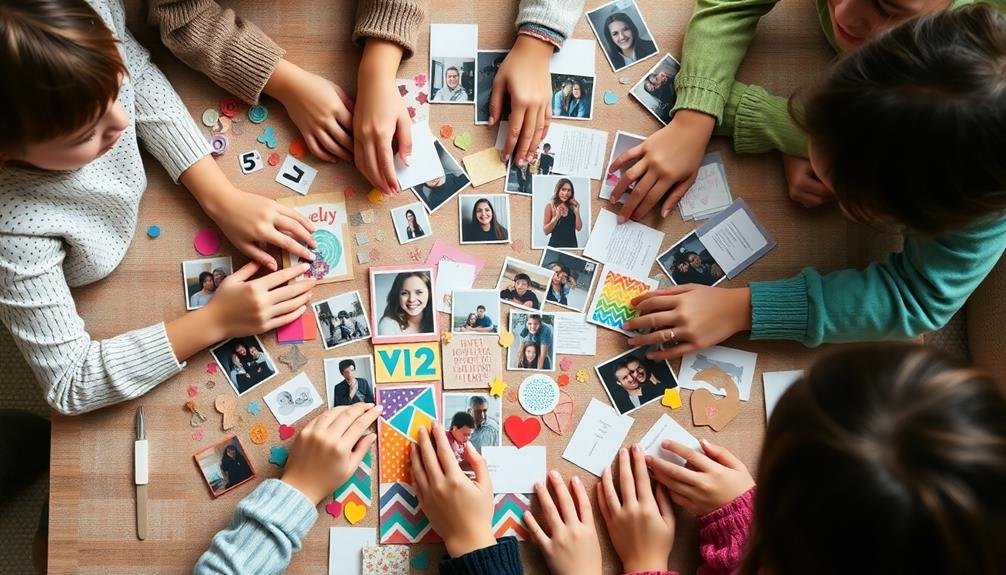
Collaborative scrapbooking offers a powerful way to heal and connect with others through shared experiences. When you engage in this activity with friends, family, or support groups, you create a safe space to process emotions and memories together. This shared journey can lead to deeper understanding, empathy, and mutual support.
To start a collaborative scrapbooking project for healing, consider these ideas:
- Host a scrapbooking circle where each person brings photos and mementos
- Create a group album focused on a shared experience or loss
- Organize a virtual scrapbooking session using video calls and digital tools
- Exchange scrapbook pages with others to build a collective story
- Collaborate on a community scrapbook for a local event or cause
As you work together, encourage open dialogue about the memories you're preserving. Share stories, laugh, cry, and support one another through the creative process.
This shared vulnerability can strengthen bonds and provide comfort during difficult times. Remember, the goal isn't perfection but rather the act of coming together to honor your shared experiences and heal collectively.
Digital Scrapbooking for Anxiety Management
For those grappling with anxiety, digital scrapbooking can be a soothing and therapeutic outlet. It combines the calming effects of creativity with the accessibility of digital tools, allowing you to craft meaningful memories from the comfort of your own space.
Unlike traditional scrapbooking, digital methods offer unlimited do-overs, reducing the pressure to create perfect layouts. Start by choosing a user-friendly digital scrapbooking platform or app. These often come with pre-designed templates and elements, making it easier to focus on the content rather than technical details.
As you work, practice mindfulness by concentrating on each photo or memory you're adding. This process can help ground you in the present moment, alleviating anxious thoughts about the future. Use journaling prompts to explore your feelings within your digital scrapbook pages. Write about positive experiences, moments of gratitude, or strategies that have helped manage your anxiety.
Incorporate calming color schemes and soothing imagery to create a visual representation of tranquility. Remember, your digital scrapbook is a personal safe space – there's no right or wrong way to express yourself.
Celebrating Progress Through Memory Journals
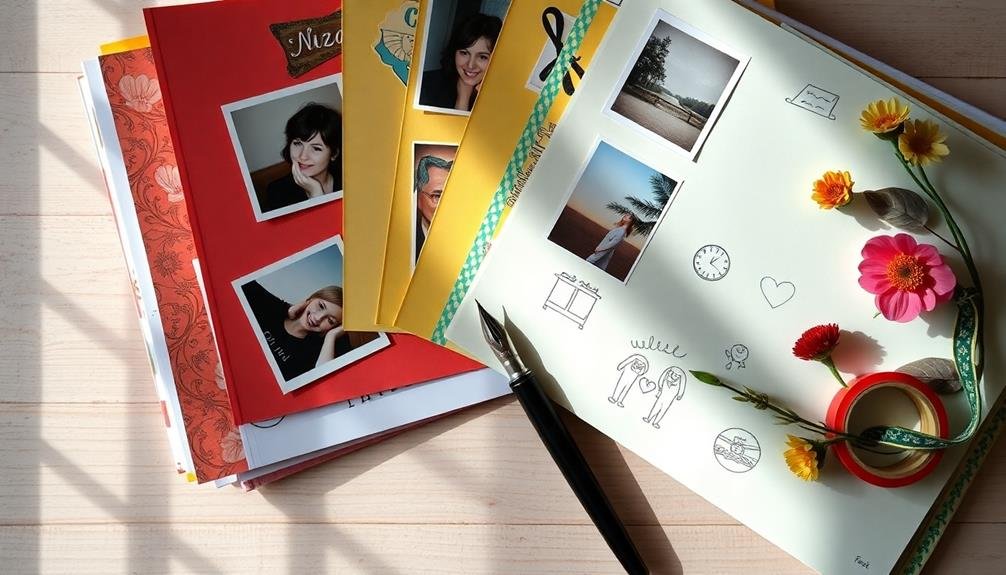
Memory journals offer a powerful way to celebrate your personal growth and achievements. By documenting your journey, you'll create a tangible record of how far you've come. This technique combines scrapbooking with journaling, allowing you to visually and verbally express your progress.
To create a memory journal that celebrates your progress, consider including:
- Before and after photos
- Milestone certificates or awards
- Quotes that inspired you
- Ticket stubs or mementos from significant events
- Handwritten reflections on your growth
As you build your memory journal, focus on specific areas of improvement. You might track your fitness journey, career advancements, or personal relationships.
Don't shy away from including setbacks; they're often stepping stones to greater success.
Update your memory journal regularly, perhaps monthly or quarterly. This practice will help you maintain perspective on your growth and provide motivation during challenging times.
You'll also develop a deeper appreciation for your resilience and adaptability.
Frequently Asked Questions
How Long Should I Spend on Therapeutic Scrapbooking Each Day?
You don't need to set a strict time limit for therapeutic scrapbooking. Aim for 15-30 minutes daily, but listen to your needs. Some days you'll want more time, others less. The key is consistency and enjoyment.
Can I Use Old Family Albums for Healing Through Memory Journaling?
You can definitely use old family albums for healing through memory journaling. They're rich sources of memories and emotions. As you browse, jot down thoughts and feelings. Don't hesitate to explore both positive and challenging experiences they evoke.
Are There Specific Color Theories That Enhance Emotional Healing in Scrapbooks?
Yes, color theories can enhance emotional healing in scrapbooks. You'll find that warm colors like red and orange evoke energy, while cool blues and greens promote calmness. Purple often represents spirituality, and yellow can boost happiness and optimism.
How Do I Protect My Privacy When Sharing Therapeutic Scrapbooks With Others?
You can protect your privacy by using symbols or codes, omitting names, focusing on feelings rather than details, and sharing selectively. Consider creating separate public and private versions. Always trust your instincts about what you're comfortable sharing.
Can Therapeutic Scrapbooking Help With Processing Traumatic Childhood Memories?
Yes, therapeutic scrapbooking can help you process traumatic childhood memories. You'll create a safe space to explore emotions, reframe experiences, and gain new perspectives. It's a powerful tool for healing and personal growth through creative expression.
In Summary
You've explored powerful techniques to heal through memory journaling and scrapbooking. Remember, it's not about perfection but progress. As you continue your journey, embrace the process and be gentle with yourself. Whether you're working solo or collaboratively, digitally or traditionally, your memory keeping practice is uniquely yours. Celebrate each step forward, no matter how small. Your scrapbook is a reflection of your resilience and growth. Keep creating, keep healing, and keep moving forward.

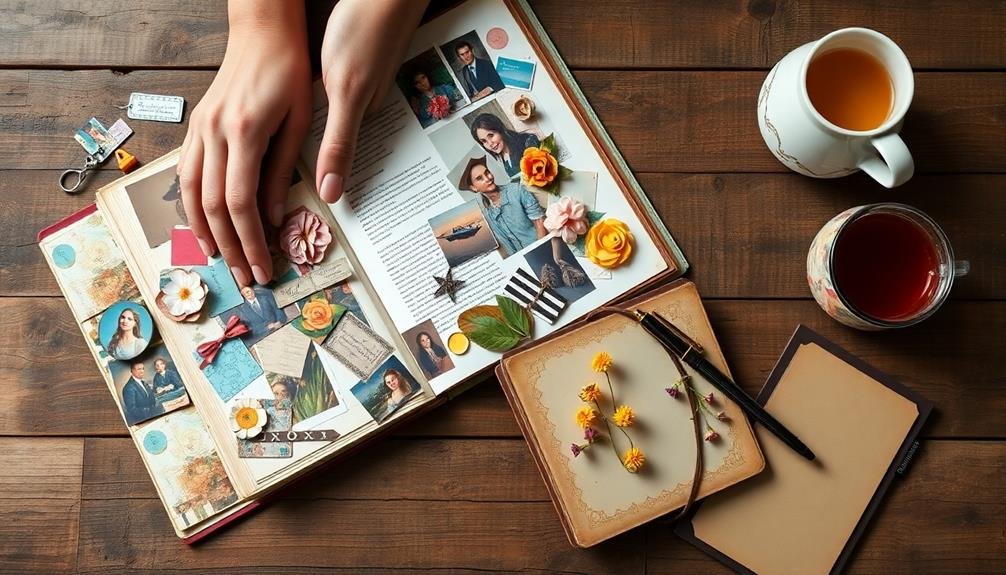



Leave a Reply